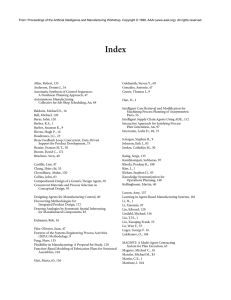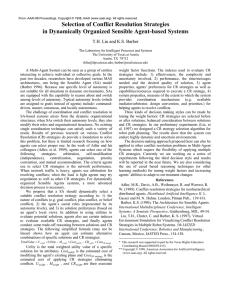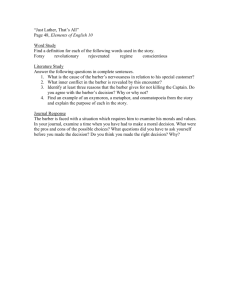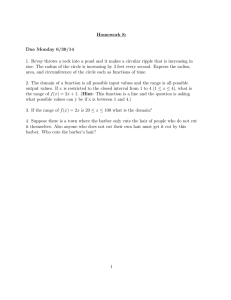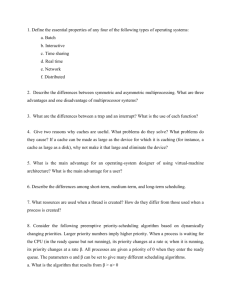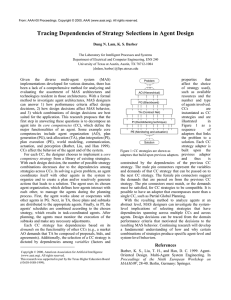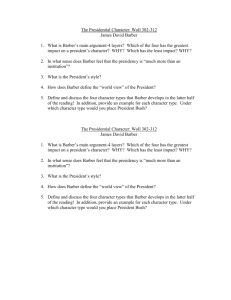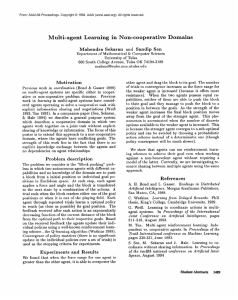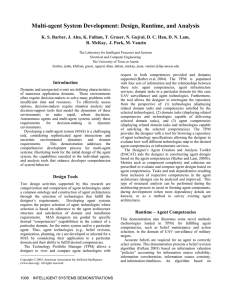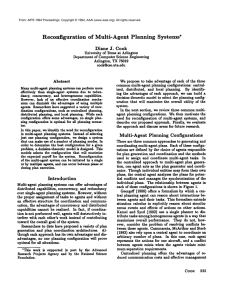A Framework for Problem Solving Activities in Multi-Agent Systems
advertisement
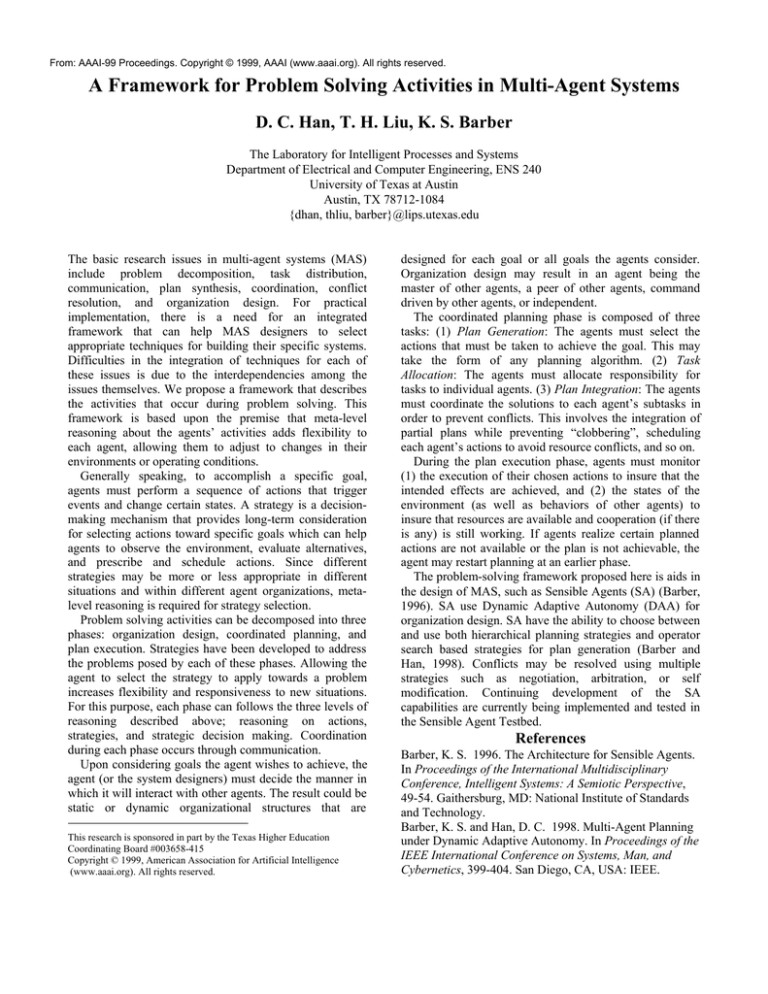
From: AAAI-99 Proceedings. Copyright © 1999, AAAI (www.aaai.org). All rights reserved.
A Framework for Problem Solving Activities in Multi-Agent Systems
D. C. Han, T. H. Liu, K. S. Barber
The Laboratory for Intelligent Processes and Systems
Department of Electrical and Computer Engineering, ENS 240
University of Texas at Austin
Austin, TX 78712-1084
{dhan, thliu, barber}@lips.utexas.edu
The basic research issues in multi-agent systems (MAS)
include problem decomposition, task distribution,
communication, plan synthesis, coordination, conflict
resolution, and organization design. For practical
implementation, there is a need for an integrated
framework that can help MAS designers to select
appropriate techniques for building their specific systems.
Difficulties in the integration of techniques for each of
these issues is due to the interdependencies among the
issues themselves. We propose a framework that describes
the activities that occur during problem solving. This
framework is based upon the premise that meta-level
reasoning about the agents’ activities adds flexibility to
each agent, allowing them to adjust to changes in their
environments or operating conditions.
Generally speaking, to accomplish a specific goal,
agents must perform a sequence of actions that trigger
events and change certain states. A strategy is a decisionmaking mechanism that provides long-term consideration
for selecting actions toward specific goals which can help
agents to observe the environment, evaluate alternatives,
and prescribe and schedule actions. Since different
strategies may be more or less appropriate in different
situations and within different agent organizations, metalevel reasoning is required for strategy selection.
Problem solving activities can be decomposed into three
phases: organization design, coordinated planning, and
plan execution. Strategies have been developed to address
the problems posed by each of these phases. Allowing the
agent to select the strategy to apply towards a problem
increases flexibility and responsiveness to new situations.
For this purpose, each phase can follows the three levels of
reasoning described above; reasoning on actions,
strategies, and strategic decision making. Coordination
during each phase occurs through communication.
Upon considering goals the agent wishes to achieve, the
agent (or the system designers) must decide the manner in
which it will interact with other agents. The result could be
static or dynamic organizational structures that are
This research is sponsored in part by the Texas Higher Education
Coordinating Board #003658-415
Copyright © 1999, American Association for Artificial Intelligence
(www.aaai.org). All rights reserved.
designed for each goal or all goals the agents consider.
Organization design may result in an agent being the
master of other agents, a peer of other agents, command
driven by other agents, or independent.
The coordinated planning phase is composed of three
tasks: (1) Plan Generation: The agents must select the
actions that must be taken to achieve the goal. This may
take the form of any planning algorithm. (2) Task
Allocation: The agents must allocate responsibility for
tasks to individual agents. (3) Plan Integration: The agents
must coordinate the solutions to each agent’s subtasks in
order to prevent conflicts. This involves the integration of
partial plans while preventing “clobbering”, scheduling
each agent’s actions to avoid resource conflicts, and so on.
During the plan execution phase, agents must monitor
(1) the execution of their chosen actions to insure that the
intended effects are achieved, and (2) the states of the
environment (as well as behaviors of other agents) to
insure that resources are available and cooperation (if there
is any) is still working. If agents realize certain planned
actions are not available or the plan is not achievable, the
agent may restart planning at an earlier phase.
The problem-solving framework proposed here is aids in
the design of MAS, such as Sensible Agents (SA) (Barber,
1996). SA use Dynamic Adaptive Autonomy (DAA) for
organization design. SA have the ability to choose between
and use both hierarchical planning strategies and operator
search based strategies for plan generation (Barber and
Han, 1998). Conflicts may be resolved using multiple
strategies such as negotiation, arbitration, or self
modification. Continuing development of the SA
capabilities are currently being implemented and tested in
the Sensible Agent Testbed.
References
Barber, K. S. 1996. The Architecture for Sensible Agents.
In Proceedings of the International Multidisciplinary
Conference, Intelligent Systems: A Semiotic Perspective,
49-54. Gaithersburg, MD: National Institute of Standards
and Technology.
Barber, K. S. and Han, D. C. 1998. Multi-Agent Planning
under Dynamic Adaptive Autonomy. In Proceedings of the
IEEE International Conference on Systems, Man, and
Cybernetics, 399-404. San Diego, CA, USA: IEEE.
